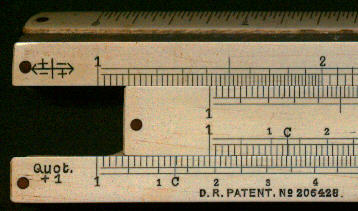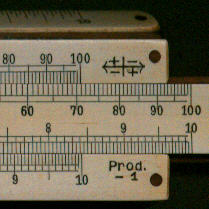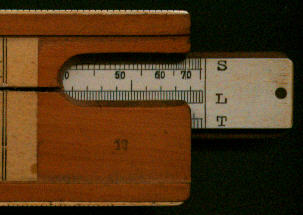1. This rule is fairly standard except for one thing - its digit
registering cursor. The object of this was to facilitate the tracking of the decimal point
when it was necessary to switch the position of the slide.
2. This rule was made from 1905 until world War I. (D. Jezierski, Slide Rules: A journey
through the centuries, p24). This model, dated to 1913, would therefore be one of the
later ones.
3. Normally a users positions the slide under the cursor using both hands, the length of
the cursor on this rule is such that for numbers from 8.5 to 10.0 this impossible and only
the left hand can be used. How rare to find something more suited to left-handers than to
right-handers! There can also be similar problems in reading the answer at the right hand
end.
4. Physically the dimensions of the rule are the same as the Faber Castell 360, though
that rule only has the markings for decimal tracking on the lower part of the stock. The
Hemmi equivalent, un-numbered but which later developed into the 40RK, also has the same
dimensions but has retained the markings on both the upper and lower parts of the stock.
5. The rules given in Snodgrass (Teach Yourself the Slide Rule) for decimal tracking
relate to the position of the slide relative to the stock. To use this cursor the rules
relate to the position of the answer in relation to the multipliers or to the dividend and
divisor.
For multiplication, if the answer is to the right of the first multiplier then 1 digit has to be subtracted from the sum of the digits. For example, for 2 times 4, the answer, 8, is to the right of the 2. The number of digits in the answer is 1 less than that the sum of the digits in the two multipliers. For 2 times 6, the answer, 12, is to the left of the 2. The number of digits in the answer is 2 which is the sum of the digits in the multipliers without modification.
For division, if the answer is to the left of the dividend than one has to be added to the difference in the number of digits. For example for 8 divided by 4, the answer, 2, is to the left of the 8. The difference in the number of digits is 0 but there is one digit in the answer so one has to be added to the difference. For 12 divided by 6, the answer, 2, is to the right of of 12. the difference in the number of digits is 1 which is the difference in the number of digits without modification.
6. Imagine, however, having to work out which of the above applied and having to move the indicator on the cursor after every stage of a calculation. Given the complication in using this cursor it is little wonder that it had such a short life!




